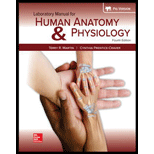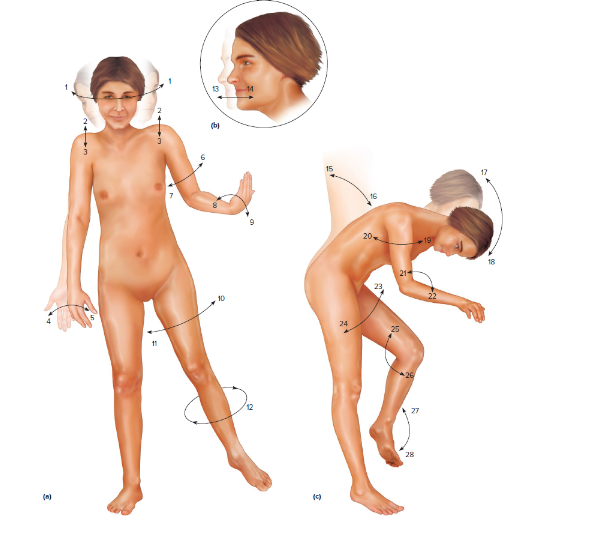
Laboratory Manual For Human Anatomy & Physiology
4th Edition
ISBN: 9781260159363
Author: Martin, Terry R., Prentice-craver, Cynthia
Publisher: McGraw-Hill Publishing Co.
expand_more
expand_more
format_list_bulleted
Concept explainers
Textbook Question
Chapter 19, Problem 5.12A
Identify the types of joint movements numbered in figure 19.8.
11. _______________________________________________ (of thigh at hip)
FIGURE 19.8 Identify each of the types of movements numbered and illustrated: (a) anterior view; (b) lateral view of head; (c) lateral view.
Source: Adapted from original concept of illustration drawn by Ross Martin.

Expert Solution & Answer
Want to see the full answer?
Check out a sample textbook solution
Students have asked these similar questions
Molecular Biology
A-C components of the question are corresponding to attached image labeled 1.
D component of the question is corresponding to attached image labeled 2.
For a eukaryotic mRNA, the sequences is as follows where AUGrepresents the start codon, the yellow is the Kozak sequence and (XXX) just represents any codonfor an amino acid (no stop codons here). G-cap and polyA tail are not shown
A. How long is the peptide produced?B. What is the function (a sentence) of the UAA highlighted in blue?C. If the sequence highlighted in blue were changed from UAA to UAG, how would that affecttranslation?
D. (1) The sequence highlighted in yellow above is moved to a new position indicated below. Howwould that affect translation? (2) How long would be the protein produced from this new mRNA?
Thank you
Molecular Biology
Question
Explain why the cell doesn’t need 61 tRNAs (one for each codon).
Please help. Thank you
Molecular Biology
You discover a disease causing mutation (indicated by the arrow) that alters splicing of its mRNA. This mutation (a base substitution in the splicing sequence) eliminates a 3’ splice site resulting in the inclusion of the second intron (I2) in the final mRNA. We are going to pretend that this intron is short having only 15 nucleotides (most introns are much longer so this is just to make things simple) with the following sequence shown below in bold. The ( ) indicate the reading frames in the exons; the included intron 2 sequences are in bold.
A. Would you expected this change to be harmful? ExplainB. If you were to do gene therapy to fix this problem, briefly explain what type of gene therapy youwould use to correct this.
Please help. Thank you
Chapter 19 Solutions
Laboratory Manual For Human Anatomy & Physiology
Ch. 19 - Pre-Lab Questions Select the correct answer for...Ch. 19 - Pre-Lab Questions Select the correct answer for...Ch. 19 - Pre-Lab Questions Select the correct answer for...Ch. 19 - Pre-Lab Questions Select the correct answer for...Ch. 19 - Pre-Lab Questions Select the correct answer for...Ch. 19 - Pre-Lab Questions Select the correct answer for...Ch. 19 - Pre-Lab Questions Select the correct answer for...Ch. 19 - Pre-Lab Questions Select the correct answer for...Ch. 19 - Match the terms in column A with the descriptions...Ch. 19 - Identify the types of structural and functional...
Ch. 19 - Identify the types of structural and functional...Ch. 19 - Identify the types of structural and functional...Ch. 19 - Identify the types of structural and functional...Ch. 19 - Identify the types of structural and functional...Ch. 19 - Identify the types of structural and functional...Ch. 19 - Identify the types of structural and functional...Ch. 19 - Identify the types of structural and functional...Ch. 19 - Identify the types of structural and functional...Ch. 19 - Identify the types of structural and functional...Ch. 19 - Match the types of synovial joints in column A...Ch. 19 - Complete the missing components of the following...Ch. 19 - Identify the types of joint movements numbered in...Ch. 19 - Identify the types of joint movements numbered in...Ch. 19 - Identify the types of joint movements numbered in...Ch. 19 - Identify the types of joint movements numbered in...Ch. 19 - Identify the types of joint movements numbered in...Ch. 19 - Identify the types of joint movements numbered in...Ch. 19 - Identify the types of joint movements numbered in...Ch. 19 - Identify the types of joint movements numbered in...Ch. 19 - Identify the types of joint movements numbered in...Ch. 19 - Identify the types of joint movements numbered in...Ch. 19 - Identify the types of joint movements numbered in...Ch. 19 - Identify the types of joint movements numbered in...Ch. 19 - Identify the types of joint movements numbered in...Ch. 19 - Identify the types of joint movements numbered in...Ch. 19 - Identify the types of joint movements numbered in...Ch. 19 - Identify the types of joint movements numbered in...Ch. 19 - Identify the types of joint movements numbered in...Ch. 19 - Identify the types of joint movements numbered in...Ch. 19 - Identify the types of joint movements numbered in...Ch. 19 - Identify the types of joint movements numbered in...Ch. 19 - Identify the types of joint movements numbered in...Ch. 19 - Identify the types of joint movements numbered in...Ch. 19 - Identify the types of joint movements numbered in...Ch. 19 - Identify the types of joint movements numbered in...Ch. 19 - Identify the types of joint movements numbered in...Ch. 19 - Identify the types of joint movements numbered in...Ch. 19 - Identify the types of joint movements numbered in...Ch. 19 - Identify the types of joint movements numbered in...
Additional Science Textbook Solutions
Find more solutions based on key concepts
True or false? Some trails are considered vestigial because they existed long ago.
Biological Science (6th Edition)
To test your knowledge, discuss the following topics with a study partner or in writing ideally from memory. Th...
HUMAN ANATOMY
An obese 55-year-old woman consults her physician about minor chest pains during exercise. Explain the physicia...
Biology: Life on Earth with Physiology (11th Edition)
Gregor Mendel never saw a gene, yet he concluded that some inherited factors were responsible for the patterns ...
Campbell Essential Biology (7th Edition)
Knowledge Booster
Learn more about
Need a deep-dive on the concept behind this application? Look no further. Learn more about this topic, biology and related others by exploring similar questions and additional content below.Similar questions
- Molecular Biology Question Please help. Thank you Explain what is meant by the term “defective virus.” Explain how a defective virus is able to replicate.arrow_forwardMolecular Biology Explain why changing the codon GGG to GGA should not be harmful. Please help . Thank youarrow_forwardStage Percent Time in Hours Interphase .60 14.4 Prophase .20 4.8 Metaphase .10 2.4 Anaphase .06 1.44 Telophase .03 .72 Cytukinesis .01 .24 Can you summarize the results in the chart and explain which phases are faster and why the slower ones are slow?arrow_forward
- Can you circle a cell in the different stages of mitosis? 1.prophase 2.metaphase 3.anaphase 4.telophase 5.cytokinesisarrow_forwardWhich microbe does not live part of its lifecycle outside humans? A. Toxoplasma gondii B. Cytomegalovirus C. Francisella tularensis D. Plasmodium falciparum explain your answer thoroughly.arrow_forwardSelect all of the following that the ablation (knockout) or ectopoic expression (gain of function) of Hox can contribute to. Another set of wings in the fruit fly, duplication of fingernails, ectopic ears in mice, excess feathers in duck/quail chimeras, and homeosis of segment 2 to jaw in Hox2a mutantsarrow_forward
- Select all of the following that changes in the MC1R gene can lead to: Changes in spots/stripes in lizards, changes in coat coloration in mice, ectopic ear formation in Siberian hamsters, and red hair in humansarrow_forwardPleiotropic genes are genes that (blank) Cause a swapping of organs/structures, are the result of duplicated sets of chromosomes, never produce protein products, and have more than one purpose/functionarrow_forwardA loss of function mutation in Pitx1 enhancers can cause (blank) Removal of Pitx1 exons and growth of ectopic hindlimbs, growth of extra ectopic forelimbs, loss of forelimb specification and development, and loss of hindlimb specification and developmentarrow_forward
- Hox1a most likely contributes to (blank) patterning in the developing embryo? Ventral, posterior, limb or anteriorarrow_forwardSelect all of the following that can help establish Hox gene expression boundaries (things that affect Hox and not things that Hox affects). Retinoic acid, anterior/posterior axis, fibroblast growth factors, vagal neural crest, and enhancersarrow_forwardEctopic expression of Hox often results in (blank) phenotypes. (Blank) transformations are characterized by the replacement of one body part/structure with another. Hoxeotic, homealoneotic, joexotic, or homeoticarrow_forward
arrow_back_ios
SEE MORE QUESTIONS
arrow_forward_ios
Recommended textbooks for you
 Medical Terminology for Health Professions, Spira...Health & NutritionISBN:9781305634350Author:Ann Ehrlich, Carol L. Schroeder, Laura Ehrlich, Katrina A. SchroederPublisher:Cengage Learning
Medical Terminology for Health Professions, Spira...Health & NutritionISBN:9781305634350Author:Ann Ehrlich, Carol L. Schroeder, Laura Ehrlich, Katrina A. SchroederPublisher:Cengage Learning Fundamentals of Sectional Anatomy: An Imaging App...BiologyISBN:9781133960867Author:Denise L. LazoPublisher:Cengage Learning
Fundamentals of Sectional Anatomy: An Imaging App...BiologyISBN:9781133960867Author:Denise L. LazoPublisher:Cengage Learning




Medical Terminology for Health Professions, Spira...
Health & Nutrition
ISBN:9781305634350
Author:Ann Ehrlich, Carol L. Schroeder, Laura Ehrlich, Katrina A. Schroeder
Publisher:Cengage Learning


Fundamentals of Sectional Anatomy: An Imaging App...
Biology
ISBN:9781133960867
Author:Denise L. Lazo
Publisher:Cengage Learning
Types of Human Body Tissue; Author: MooMooMath and Science;https://www.youtube.com/watch?v=O0ZvbPak4ck;License: Standard YouTube License, CC-BY